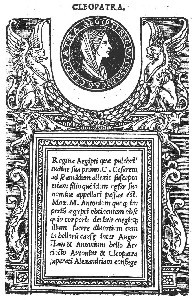
2000 Years of Writing and Printing in Italy
Instructor: Dr. John Cunnally
Description and Syllabus
 |
Art H 498, The Art History
of the Book: 2000 Years of Writing and Printing in Italy Instructor: Dr. John Cunnally Description and Syllabus
|
Welcome to The Art History of the Book, a survey course in the evolution of the written word (and the visual art that often accompanies it) from ancient inscriptions and rotuli (scrolls) to the medieval codex and the printed book of the Renaissance and later. The course is taught at the ISU College of Design's Rome campus (Palazzo Cenci), July 2-27 2007. We will spend as little time in the classroom as possible and instead make use of museums and the famous public and ecclesiastical libraries of Rome for our visual aids.
Classes are normally scheduled 8 AM to 12 noon, MWF, with the first hour devoted to lecture and discussion at the Cenci Studio and the remaining time occupied by a field trip to a local museum, collection, or library. Exceptions are two dates devoted to all-day trips, one to the Monte Cassino Abbey and Museum, the other to the Museo Bodoni in Parma, tentatively set for Wednesday July 11 (Monte Cassino) and Wednesday July 25 (Parma).
Assignments include three take-home exams and one cumulative final exam (see below for dates), and a 20-minute class presentation on some topic involving the art of the book. The presentations are scheduled for the last day of class, July 25. Other deadlines--the proposal of a topic, the writing of an outline and bibliography, and the submission of a rough draft--are indicated in the time-line below. Students are expected to critique or peer-review each other's presentations at the various stages of proposal, outline, rough draft, and final performance. If you are taking this course for graduate credit (as Art H 598) you must fulfill an additional research project which we can mutually agree upon early in the term.
For determining the final grade, I will follow this formula: exams (45%), presentation (25%), attendance, peer review activity, and class participation (30%). Regrettably, I will not be able to give full credit for assignments turned in late without a valid excuse. With regard to missing classes, I have one invariable rule: you are allowed to miss as many classes as I do. Your presence at every lecture and field trip is required as a courtesy to your instructor, to your fellow students, to the taxpayers who are subsidizing your tuition, to the departed scholars and creators who have contributed to this branch of knowledge (often under conditions of great hardship, sacrifice, and persecution), and to the spirit of learning.
Tentative schedule as of April 2007 (a final schedule will be distributed in class July 2):
Part One: Antiquity (July 2-6).
Topics include: The evolution of the Latin alphabet and ancient scripts;
development of the rotulus (scroll book) and codex (volume book); techniques and
materials of the Greek and Roman scribes; ancient libraries and methods of
publication.
Field trips include: The Vatican Museum, the Epigraphic Collection of the
Museo Nazionale.
Presentation: One-page topic proposal due July 6.
Exam: Take-home test distributed July 6, due July 9.
Note: Other arrangements for the test and the proposal deadlines will be
made for students participating in the LA 309 Field Trip (July 6-9).
Part Two: The Middle Ages (July 9-13).
Topics include: Medieval scripts and schools of illumination; the role of
the Church and the monastic orders; methods and materials of the medieval
scribe; the evolution of early bookbinding.
Field trips include: Monte Cassino Abbey, The Vatican Library.
Peer review: Critique/response to topic proposals due July 11.
Presentation: One-page outline and one-page annotated bibliography due
July 13.
Exam: Take-home test distributed July 13, due July 16.
Part Three: The Renaissance (July 16-20).
Topics include: Invention and spread of printing of texts and images;
revival of classicism and humanism in font design, illustration, and
bookbinding; the impact of the Reformation and popular literacy; the evolution
of the book trade and censorship.
Field trips include: The Biblioteca Angelica and Biblioteca Casanatense
in Rome.
Peer review: Critique/response to outlines and bibliographies due July
18.
Presentation: Rough draft of presentation due July 20.
Exam: Take-home test distributed July 20, due July 23.
Part Four: The Modern Age (July 23-27).
Topics include: Mechanization of paper production and publishing; modern
styles of fonts and new technologies of illustration; the impact of science and
the Enlightenment; the role of the eighteenth century revolutions and the rise
of the bourgeoisie; proliferation of newspapers, magazines, popular fiction,
advertising and mass media.
Field trips include: The Biblioteca Nazionale Centrale in Rome, the
Bodoni Museum in Parma.
Peer review: Critique/response to rough drafts due July 25;
critique/response to final presentations due at the end of class on July 27.
Presentation: Class presentations scheduled for July 27.
Exam: Take-home final exam distributed July 27, due July 30.
Picture credit: Andrea Fulvio, Illustrium Imagines, Rome 1517, letterpress with woodcut illustrations, courtesy of the John M. Wing Foundation, The Newberry Library, Chicago.
Printer-friendly (text only) version of this syllabus.
Syllabus for Art H 378, Popes and Caesars.